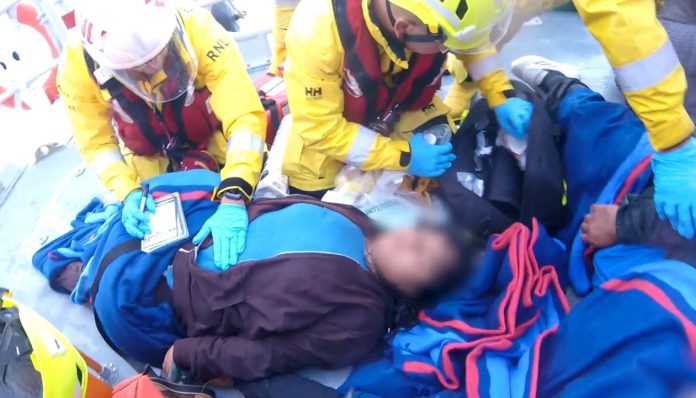The Royal National Lifeboat Institution (RNLI) has released new footage and a crew testimony to give a first-hand insight into what the charity’s volunteer crews often face when they rescue people crossing the English Channel.
The harrowing footage – captured on the helmet cameras of the lifeboat crew from Dover RNLI – is from a recent shout to five people attempting to cross one of the world’s busiest shipping lanes to reach the UK.
Among the casualties were a family of four – including a 14-year-old girl – believed to be from Afghanistan, who were all cared for by the lifeboat crew.
WARNING: Contains footage and detail which may be distressing.
An RNLI crew member, who has responded to similar shouts in the Channel, has also written a first-hand account of what he and his fellow volunteers often face when they launch at the request of HM Coastguard.
‘We are all trained in casualty care,’ he said. ‘Recently, we have received extra training in, not only how to assist a childbirth at sea, but also what to do should we come across tens of bodies floating face down in the water. Our greatest terror is not if, but when.
‘Dinghies are always packed the same way – women and children huddled on the thin plywood floor, men on the outside, seated on the inflated hull. It used to be that dinghies only had 20 people in them. Now, we often pick up vessels with two or three times that amount. The dinghy bottom is usually swilling with a mixture of seawater, petrol and vomit.
‘Floating on top of this highly inflammable, rank cocktail – among the plastic bags and spoiled belongings – you might also see a foot pump and a pile of floppy bicycle inner tubes in case the boat sinks. This is because the buoyancy aids supplied by the traffickers are sometimes stuffed with little more than cardboard.
‘Even on a mild day, somewhere on the imaginary line between the UK and France, the swell can slop about uneasily and an overloaded dinghy will flex dangerously against its glued seams. Coming across a dinghy in anything more than these conditions makes mouths go dry.
‘There is an unspoken fear among crew that a dinghy will split apart as people rush and clamber over its sides. This is where the skill of the coxswain is truly remarkable for, whatever the weather, he manoeuvres our boat into such a position that we are close enough to start pulling people across. Getting them onboard is rarely pretty.
‘We pass lines to outstretched palms to thread through carry handles at the bow and stern of the dinghy; that way, we can bring it alongside and, in theory, the people can step across quickly and safely. But because the boats are cheap and cynically made for one purpose only, the handles quickly come away under load. That’s when people start to panic.
‘This is the most terrifying part. Some hold up their children, hoping we will save the most vulnerable first. Others just make a leap for it, scrambling across the churning gap between the boats, hoping that their strength will be enough to save them. All we can do is our best.
‘As the two vessels lurch unevenly side by side, rearing up and down, it feels overwhelmingly chaotic. I’ve seen parents throw their babies across; I’ve seen others trampling neighbours to the floor; I’ve seen men fighting as they struggle to hold one another back; I’ve seen terror as old women hold up clasped hands in prayer, not looking to us but instead to the sky.
‘All we can do is pack the deck as evenly as possible, putting the youngest and fittest-looking men at the bow and bringing women and families inside.
‘We hand out blankets and waterproof ponchos to those outside and chocolate to the rest. Moving about on deck is almost impossible for crew, such is the crush and sprawl of bodies. One of the crew shows episodes of Peppa Pig on a mobile screen to children with wide eyes, dirty cheeks and runny noses. Some of them look like my daughter’s friends from school. I have discovered that all parents – wherever they come from – are grateful for Peppa Pig on a long journey.
‘Often, people are seasick, retching over the side or through fingers, making the decks slippy. Either that or they are suffering from cold or exhaustion or dehydration. Others come with injuries picked up on the way. Some are missing limbs. Some are blind or deaf. Others are old and infirm. Some are pregnant. Many come with stories.’
The RNLI’s Head of Lifeboats, Simon Ling, said: ‘The crew testimony and rescue footage show the reality of what our volunteer lifeboat crews face when they launch to the aid of people crossing the Channel at the request of HM Coastguard. We are incredibly proud of our crews who continue to respond selflessly to their pagers, day or night, simply to help others. They have responded in a humbling way to this increase in demand with continued dedication, commitment and compassion.
‘Each time our crews are requested to launch by HM Coastguard they do so knowing that someone’s father, mother, son or daughter could end up in the water and need help. They understand the potential human cost so leave behind their own families and employment to go to the aid of others. We thank them for their selflessness.
‘The challenges our crews face in this demanding search and rescue environment continue to evolve and we are continually developing new ways we can support our teams to ensure they have the best and most suitable care, protection, equipment, and training available. The welfare of our crews is extremely important to us.’
The RNLI has been working with crews to consider and test new equipment more specifically suited for responding to incidents in the Channel with much of it now in use, including inflatable horseshoe life rings and rafts and translation cards to aid communication with people from a variety of different countries.
The charity has also increased operational staffing, where necessary, so that stations are able to give breaks to volunteers who are being tasked repeatedly in the space of a few days.
Last week, south east crew members participated in a mass rescue simulation to help prepare for emergency incidents involving large numbers of people in the water building on smaller-scale exercises conducted earlier this year, including one in the state-of-the-art sea survival pool at the RNLI College in Poole, Dorset.
Simon Ling added: ‘Our crews face a difficult and ever-changing environment in the Channel and, for some of our stations, the scale of their involvement is unprecedented.
‘We are accustomed to seeing spikes in activity around our coast throughout the summer months, partly as a result of new trends in water use but seeing year-round increases in launches and the potential impact these types of rescues have on our crew’s emotional wellbeing is not something the RNLI has been faced with before.
‘We recognise there is more work to be done in support of our crews and this work and everyone at the RNLI remains focused on our core purpose of saving lives at sea.’





















